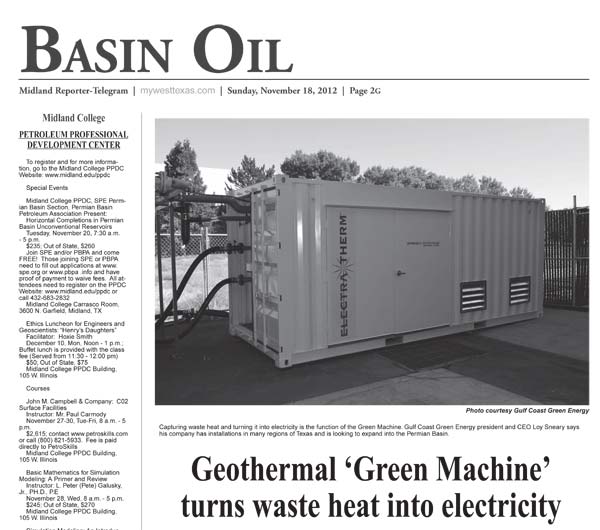Posted: Wednesday, November 21, 2012 11:23 am | Updated: 11:26 am, Wed Nov 21, 2012.
By Paul Wiseman
Special to the Oil Report
A device called the “Green Machine” is turning waste heat from generator exhaust, gas compressors, produced water and other sources into electricity across Texas and as far away as the island of Cyprus.
Loy Sneary, president and CEO of Bay City, Texas-based Gulf Coast Green Energy, which markets the device in Texas and other Gulf states, said the company is looking into the feasibility of capturing heat from natural gas flares as well, although they have not yet field tested that procedure.
The Green Machine was developed seven or eight years ago by ElectraTherm, headquartered in Reno, Nevada. The heart of the machine is its twin screw expander, which operates in reverse of a twin screw compressor commonly used in natural gas transmission, Sneary explained. The expander was developed and patented by City University London’s Centre for Positive Displacement Compressors, which granted ElectraTherm the right to incorporate it into what became the Green Machine.
Its first test was conducted five years ago on boilers at SMU in Dallas. Originally set as a six-month test, the time period was extended to two years. Maria Richards, SMU Geothermal Laboratory coordinator, said the trial was extended for two reasons: It was deemed a success, and the school’s engineering students were able to work with the machine, learn how it worked and experiment with improvements.
The university would have bought a machine for permanent use but when the trial ended in 2008, the banking bust was in full swing. That reduced enrollment, cut the value of endowments and pushed the school to put a moratorium on any capital expenditures, including the Green Machine, said Richards.
For the apparatus to collect heat, a hot liquid is run across a heat exchanger filled with a refrigerant with a boiling point of 53° F. In the process of transferring the heat from the liquid, such as produced water, to the refrigerant, the liquid is cooled. The heated refrigerant then turns the twin screws in the expander, operating a generator that creates electricity.
Because the Green Machine uses an induction generator it cannot operate on a freestanding basis — it must tie into an existing power grid, whether from a utility or from an array of diesel generators on site. With the grid in place, Sneary noted, connecting the Green Machine is simple. “An electrician goes out there and it takes about 30 minutes — it’s three wires and a ground. He puts it into the main bus, and it just goes into the system.”
On a well producing 3,000-4,000 barrels of water at 200-270 degrees F, a Green Machine could make 65 kw/hour of electricity, “enough to power 60 homes,” according to Sneary.
The machine produces 480-volt three-phase power. Since most sites that use a Green Machine are in rural areas, the power mostly comes from cooperatives. These companies install dual meters on the pole, which monitor how much power is used and how much is generated onsite. Sneary said most sites use more power than the Green Machine can produce, so the producer pays the power company the difference.
While the payout period seems long at approximately four years, Sneary pointed out that the machine is designed to last 20 years and to be easily moved from site to site by a standard fork lift. He also recalled that the state’s power grid is expected to be strained over the next several years due to population growth, so any power reduction will help existing resources last longer.
On sites with diesel generators, Sneary said the machine could use exhaust heat and jacket water from those compressors to make more electricity, with the effect of making those generators more efficient.
At a natural gas compressor station the temperature of the gas, once compressed, often rises to 275° F, which is about twice the temperature allowed into the stream. By using a Green Machine, Sneary noted, a company would not only generate electricity, it would cool the gas down close to an acceptable temperature. They could then use the generated electricity to run the fans needed to cool the gas the rest of the way. Studies have shown they can reduce power used in this context by 80 percent. Gulf Coast is currently looking for a partner to let them test this procedure in the Permian Basin in a commercial application. Previous tests have been on a smaller scale.
Gulf Coast Green Energy has installations in the Eagle Ford Shale, is running a pilot project on a gas compressor station in north central Texas, and is looking to expand into the Permian Basin. The Basin expansion is the driving force behind the experiments with gas flares. To represent them in this area, the company has enlisted Dr. Richard Erdlac, a noted green energy expert.
Read more: Geothermal ‘Green Machine’ turns waste heat into electricity – Mywesttexas.com: Top Stories
Under Creative Commons License: Attribution

